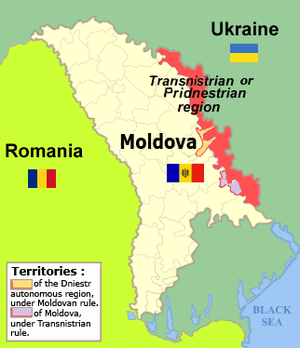Transnistria
Transnistria, Transdniestria, or Pridnestrovie, officially the Pridnestrovian Moldavian Republic[lower-alpha 1] (PMR; Russian: Приднестровская Молдавская Республика, romanized: Pridnestrovskaya Moldavskaya Respublika), is a breakaway state in a narrow strip of land between the river Dniester and the Ukrainian border that is internationally recognized as part of Moldova. Its capital is Tiraspol. Transnistria has been recognised only by three other mostly non-recognised states: Abkhazia, Artsakh, and South Ossetia.[8]
Pridnestrovian Moldavian Republic | |
|---|---|
Anthem: Мы славим тебя, Приднестровье (Russian) My slavim tebja, Pridnestrovje (transliteration) We sing the praises of Transnistria | |
.svg.png) | |
| Status | Unrecognised state Recognised by the United Nations as de jure part of Moldova |
| Capital and largest city | Tiraspol |
| Official languages | |
| Inter-ethnic language | Russian[2][3][4] |
| Ethnic groups (2015 census) |
|
| Demonym(s) | Transnistrian, Pridnestrovian |
| Government | Unitary semi-presidential republic |
| Vadim Krasnoselsky | |
| Aleksandr Martynov | |
| Alexander Shcherba | |
| Legislature | Supreme Council |
| Partially recognised state | |
• Independence from SSR of Moldova declared | 2 September 1990 |
• Independence from Soviet Union declared | 25 August 1991 |
• Succeeds the Pridnestrovian Moldavian Soviet Socialist Republic | 5 November 1991[5] |
| 2 March – 21 July 1992 | |
• Recognition | 3 non-UN membersc |
| Area | |
• Total | 4,163 km2 (1,607 sq mi) |
• Water (%) | 2.35 |
| Population | |
• 2018 estimate | 469,000[6] |
• Density | 114/km2 (295.3/sq mi) |
| GDP (nominal) | 2007[7] estimate |
• Total | US$1.0 billion |
• Per capita | US$2,000 |
| Currency | Transnistrian rubled (PRB) |
| Time zone | UTC+2 (EET) |
| UTC+3 (EEST) | |
| Calling code | +373e |
| Internet TLD | nonef |
| |
_(semi-secession).svg.png)
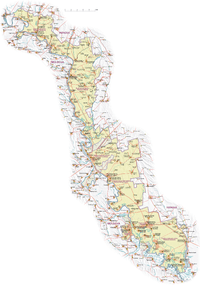
Transnistria is designated by the Republic of Moldova as the Transnistria autonomous territorial unit with special legal status (Romanian: Unitatea teritorială autonomă cu statut juridic special Transnistria),[9] or Stînga Nistrului ("Left Bank of the Dniester").[10][11][12]
After the dissolution of the USSR, tensions between Moldova and the breakaway Transnistrian territory escalated into a military conflict that started in March 1992 and was concluded by a ceasefire in July of the same year. As part of that agreement, a three-party (Russia, Moldova, Transnistria) Joint Control Commission supervises the security arrangements in the demilitarised zone, comprising twenty localities on both sides of the river. Although the ceasefire has held, the territory's political status remains unresolved: Transnistria is an unrecognised but de facto independent semi-presidential republic with its own government, parliament, military, police, postal system, currency and vehicle registration.[13][14][15][16] Its authorities have adopted a constitution, flag, national anthem and coat of arms. It is the only country still using the hammer and sickle on its flag, despite not being a socialist state.
After a 2005 agreement between Moldova and Ukraine, all Transnistrian companies that seek to export goods through the Ukrainian border must be registered with the Moldovan authorities.[17] This agreement was implemented after the European Union Border Assistance Mission to Moldova and Ukraine (EUBAM) took force in 2005.[18] Most Transnistrians also have Moldovan citizenship,[19] but many Transnistrians also have Russian and Ukrainian citizenship. The main ethnic groups in 2015 were Russians (34%), Moldovans (33%), Ukrainians (26.7%) and Bulgarians (2.8%)
Transnistria, Abkhazia, South Ossetia, and Artsakh are post-Soviet "frozen conflict" zones.[20][21] These four partially recognised states maintain friendly relations with each other and form the Community for Democracy and Rights of Nations.[22][23][24]
Names
The region can also be referred to in English as Trans-Dniestr[25] or Transdniestria.[26] These names are adaptations of the Romanian colloquial name of the region, Transnistria meaning "beyond the River Dniester".
The documents of the government of Moldova refer to the region as Stînga Nistrului (in full, Unitățile Administrativ-Teritoriale din Stînga Nistrului) meaning "Left Bank of the Dniester" (in full, "Administrative-territorial unit(s) of the Left Bank of the Dniester").
According to the Transnistrian authorities, the name of the state is Pridnestrovian Moldavian Republic (PMR) (Russian: Приднестровская Молдавская Республика, ПМР, Pridnestrovskaya Moldavskaya Respublika; Moldovan Cyrillic alphabet: Република Молдовеняскэ Нистрянэ, РМН, Republica Moldovenească Nistreană; Ukrainian: Придністровська Молдавська Республіка, ПМР, Prydnistrovs'ka Moldavs'ka Respublika). The short form of this name is Pridnestrovie (Russian: Приднестровье, Pridnestrovye; Moldovan Cyrillic alphabet: Нистрения,[27] Nistrenia; Ukrainian: Придністров'я, Prydnistrovya). Pridnestrovie is a transliteration of the Russian Приднестровье meaning "[a land] by the [River] Dniester".
History
Soviet and Romanian administration
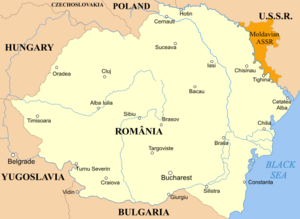
Transnistria became an autonomous political entity in 1924 with the proclamation of the Moldavian ASSR, which included today's Transnistria (4,000 km2, 1,600 sq. mi.) and an adjacent area (9,000 km2, 3,500 sq. mi.) around the city of Balta in modern-day Ukraine, but nothing from Bessarabia, which at the time formed part of Romania. One of the reasons for the creation of the Moldavian ASSR was the desire of the Soviet Union at the time to eventually incorporate Bessarabia. The Moldavian SSR, organised by a decision of the Supreme Soviet of the USSR on 2 August 1940, was formed out of a part of Bessarabia (taken from Romania on 28 June, after the Molotov–Ribbentrop Pact) and out of a part of the Moldavian ASSR roughly equivalent to present-day Transnistria.
In 1941, after Axis forces invaded the Soviet Union during the Second World War, they defeated the Soviet troops in the region and occupied it. Romania controlled the entire region between Dniester and Southern Bug rivers, including the city of Odessa as local capital.[28]
The Romanian-administered territory – called the Transnistria Governorate – with an area of 44,000 km2 (17,000 sq. mi.) and a population of 2.3 million inhabitants, was divided into 13 counties: Ananiev, Balta, Berzovca, Dubasari, Golta, Jugastru, Movilau, Oceacov, Odessa, Ovidiopol, Rîbnița, Tiraspol and Tulcin. This enlarged Transnistria was home to nearly 200,000 Romanian/Moldovan-speaking residents.
The Romanian administration of Transnistria attempted to stabilise the situation in the area under Romanian control, implementing a process of Romanianization.[29]
During the Romanian occupation of 1941–44, between 150,000 and 250,000 Ukrainian and Romanian Jews were deported to Transnistria; the majority were executed or died from other causes in ghettos and concentration camps of the Governorate.[30]
After the Red Army reconquered the area in 1944, Soviet authorities executed, exiled or imprisoned hundreds of the Moldavian SSR inhabitants in the following months on charges of collaboration with the "German-fascist occupiers". A later campaign was directed against the rich peasant families, who were deported to Kazakhstan and Siberia. Over the course of two days, 6–7 July 1949, a plan named "Operation South" saw the deportation of over 11,342 families by order of the Moldovian Minister of State Security, Iosif Mordovets.[31]
Secession
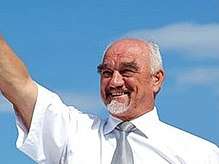
In the 1980s, Mikhail Gorbachev's policies of perestroika and glasnost in the Soviet Union allowed political liberalisation at a regional level. This led to the creation of various informal movements all over the country, and to a rise of nationalism within most Soviet republics. In the Moldavian SSR in particular, there was a significant resurgence of pro-Romanian nationalism among ethnic Moldovans.[32] The most prominent of these movements was the Popular Front of Moldova. In the spring of 1988, PFM demanded that the Soviet authorities declare Moldovan the only state language, return to the use of the Latin alphabet, and recognise the shared ethnic identity of Moldovans and Romanians. The more radical factions of the Popular Front espoused extreme anti-minority, ethnocentric and chauvinist positions,[33][34] calling for minority populations, particularly the Slavs (mainly Russians and Ukrainians) and Gagauz, to leave or be expelled from Moldova.[35]
On 31 August 1989, the Supreme Soviet of the Moldavian SSR adopted Moldovan as the only official language with Russian retained only for secondary purposes, returned Moldovan to the Latin alphabet, and declared a shared Moldovan-Romanian linguistic identity. As plans for major cultural changes in Moldova were made public, tensions rose further. Ethnic minorities felt threatened by the prospects of removing Russian as the official language, which served as the medium of interethnic communication, and by the possible future reunification of Moldova and Romania, as well as the ethnocentric rhetoric of the Popular Front. The Yedinstvo (Unity) Movement, established by the Slavic population of Moldova, pressed for equal status to be given to both Russian and Moldovan.[36] Transnistria's ethnic and linguistic composition differed significantly from most of the rest of Moldova. The share of ethnic Russians and Ukrainians was especially high and an overall majority of the population, some of them ethnic Moldovans, spoke Russian as a mother tongue.[37] Ethnic Moldovans accounted for less than 40% of Transnistria's population in 1989.
.jpg)
The nationalist Popular Front won the first free parliamentary elections in the Moldavian SSR in the spring of 1990,[38] and its agenda started slowly to be implemented. On 2 September 1990, the Pridnestrovian Moldavian Soviet Socialist Republic was proclaimed as a Soviet republic by an ad hoc assembly, the Second Congress of the Peoples' Representatives of Transnistria. Violence escalated when in October 1990 the Popular Front called for volunteers to form armed militias to stop an autonomy referendum in Gagauzia, which had an even higher share of ethnic minorities. In response, volunteer militias were formed in Transnistria. In April 1990, nationalist mobs attacked ethnic Russian members of parliament, while the Moldovan police refused to intervene or restore order.[39]
In the interest of preserving a unified Moldavian SSR within the USSR and preventing the situation escalating further, then Soviet President Mikhail Gorbachev, while citing the restriction of civil rights of ethnic minorities by Moldova as the cause of the dispute, declared the Transnistria proclamation to be lacking legal basis and annulled it by presidential decree on 22 December 1990.[40][41] Nevertheless, no significant action was taken against Transnistria and the new authorities were slowly able to establish control of the region.
Transnistria War
The Transnistria War followed armed clashes on a limited scale that broke out between Transnistrian separatists and Moldova as early as November 1990 at Dubăsari. Volunteers, including Cossacks, came from Russia to help the separatist side.[42] In mid-April 1992, under the agreements on the split of the military equipment of the former Soviet Union negotiated between the former 15 republics in the previous months, Moldova created its own Defence Ministry. According to the decree of its creation, most of the 14th Soviet Army's military equipment was to be retained by Moldova.[43] Starting from 2 March 1992, there was concerted military action between Moldova and Transnistria. The fighting intensified throughout early 1992. The former Soviet 14th Guards Army entered the conflict in its final stage, opening fire against Moldovan forces;[43] approximately 700 people were killed. Moldova has since then exercised no effective control or influence on Transnistrian authorities. A ceasefire agreement, signed on 21 July 1992, has held to the present day.
Further negotiations
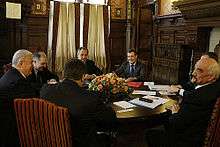
The Organization for Security and Co-operation in Europe (OSCE) is trying to facilitate a negotiated settlement. Under OSCE auspices, on 8 May 1997, Moldovan President Petru Lucinschi and Transnistrian president Igor Smirnov, signed the "Memorandum on the principles of normalization of the relations between the Republic of Moldova and Transnistria", also known as the "Primakov Memorandum", sustaining the establishment of legal and state relations, although the memorandum's provisions were interpreted differently by the governments of Moldova and Transnistria.
In November 2003, Dmitry Kozak, a counselor of Russian president Vladimir Putin, proposed a memorandum on the creation of an asymmetric federal Moldovan state, with Moldova holding a majority and Transnistria being a minority part of the federation.[44] Known as "the Kozak memorandum", it did not coincide with the Transnistrian position, which sought equal status between Transnistria and Moldova, but gave Transnistria veto powers over future constitutional changes; this encouraged Transnistria to sign it. Vladimir Voronin was initially supportive of the plan, but refused to sign it after internal opposition and international pressure from the OSCE and US, and after Russia had endorsed the Transnistrian demand to maintain a Russian military presence for the next 20 years as a guarantee for the intended federation.[45]
Talks were started in 2006 to deal with the problems, but without results for many years. In February 2011 the so-called "5 + 2 Talks" (thus named because they were carried out by Transnistria, Moldova, Ukraine, Russia and the OSCE, plus the US and the EU as external observers) were started again in Vienna.[46] After the annexation of the Crimea by Russia in March 2014, the head of the Transnistrian parliament asked to join the Russian Federation.[47][48][49]
Geography
Transnistria is landlocked and borders Bessarabia (i.e., the rest of Moldova, for 411 km, 255 miles) to the west, and Ukraine (for 405 km, 250 miles) to the east. It is a narrow valley stretching north-south along the bank of the Dniester river, which forms a natural boundary along most of the border with (the rest of) Moldova.
The territory controlled by the PMR is mostly, but not completely, coincident with the left (eastern) bank of Dniester. It includes ten cities and towns, and 69 communes, with a total of 147 localities (counting the unincorporated ones as well). Six communes on the left bank (Cocieri, Molovata Nouă, Corjova, Pîrîta, Coșnița, and Doroțcaia) remained under the control of the Moldovan government after the War of Transnistria in 1992, as part of the Dubăsari District. They are situated north and south of the city of Dubăsari, which itself is under PMR control. The village of Roghi of Molovata Nouă Commune is also controlled by the PMR (Moldova controls the other nine of the ten villages of the six communes).
On the west bank, in Bessarabia, the city of Bender and four communes (containing six villages) to its east, south-east, and south, on the opposite bank of the river Dniester from the city of Tiraspol (Proteagailovca, Gîsca, Chițcani, and Cremenciug) are controlled by the PMR.
The localities controlled by Moldova on the eastern bank, the village of Roghi, and the city of Dubăsari (situated on the eastern bank and controlled by the PMR) form a security zone along with the six villages and one city controlled by the PMR on the western bank, as well as two (Varnița and Copanca) on the same west bank under Moldovan control. The security situation inside it is subject to the Joint Control Commission rulings.
The main transportation route in Transnistria is the road from Tiraspol to Rîbnița through Dubăsari. North and south of Dubăsari it passes through the lands of the villages controlled by Moldova (Doroțcaia, Cocieri, Roghi, while Vasilievca is entirely situated east of the road). Conflict erupted on several occasions when the PMR prevented the villagers from reaching their farmland east of the road.[50][51][52]
Transnistrians are able to travel (normally without difficulty) in and out of the territory under PMR control to neighbouring Moldovan-controlled territory, to Ukraine, and on to Russia, by road or (when service is not interrupted by political tensions) on two international trains, the year-round Moscow-Chișinău, and the seasonal Saratov-Varna. International air travellers rely on the airport in Chișinău, the Moldovan capital, or the airport in Odessa, in Ukraine.
Administrative divisions
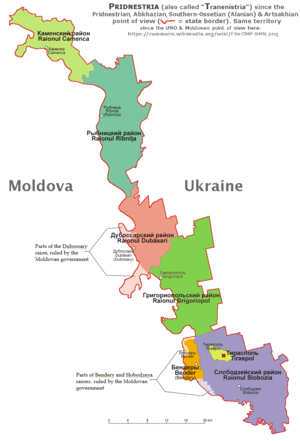
Transnistria is subdivided into five districts (raions) and one municipality, the City of Tiraspol (which is entirely surrounded by but administratively distinct from Slobozia District), listed below from north to south (Russian names and transliterations are appended in parentheses). In addition, another municipality, the City of Bender, situated on the western bank of the Dniester, in Bessarabia, and geographically outside Transnistria, is not part of the territorial unit of Transnistria as defined by the Moldovan central authorities, but it is controlled by the PMR authorities, which consider it part of PMR's administrative organisation:
| Name | Area | Population (2015) | Ethnic composition (2004) |
|---|---|---|---|
| Camenca District (Кáменка, Kamenka) | 436 square kilometres (168 sq mi) | 21,000 | 47.82% Moldovans, 42.55% Ukrainians, 6.89% Russians, 2.74% others |
| Rîbnița District (Рыбница, Rybnitsa) | 850 square kilometres (330 sq mi) | 69,000 | 29.90% Moldovans, 45.41% Ukrainians, 17.22% Russians, 7.47% others |
| Dubăsari District (Дубоссáры, Dubossary) | 381 square kilometres (147 sq mi) | 31,000 | 50.15% Moldovans, 28.29% Ukrainians, 19.03% Russians, 2.53% others |
| Grigoriopol District (Григорио́поль, Grigoriopol') | 822 square kilometres (317 sq mi) | 40,000 | 64.83% Moldovans, 15.28% Ukrainians, 17.36% Russians, 2.26% others |
| Slobozia District (Слободзе́я, Slobodzeya) | 873 square kilometres (337 sq mi) | 84,000 | 41.51% Moldovans, 21.71% Ukrainians, 26.51% Russians, 10.27% others |
| City of Tiraspol (Тира́споль) | 205 square kilometres (79 sq mi) | 129,000 | 18.41% Moldovans, 32.31% Ukrainians, 41.44% Russians, 7.84% others |
| City of Bender (Tighina; Бендéры) | 97 square kilometres (37 sq mi) | 91,000 | 25.03% Moldovans, 17.98% Ukrainians, 43.35% Russians, 13.64% others |
Each of the districts is further divided into cities and communes.
Political status
All UN member states consider Transnistria a legal part of the Republic of Moldova. Only the partially recognised states of South Ossetia, Artsakh, and Abkhazia have recognised Transnistria as a sovereign entity after it declared independence from Moldova in 1990 with Tiraspol as its declared capital.
Between 1929 and 1940, Tiraspol functioned as the capital of the Moldavian ASSR, an autonomous republic that existed from 1924 to 1940 within the Ukrainian SSR .
Although exercising no direct control over the territory of Transnistria, the Moldovan government passed the "Law on Basic Provisions of the Special Legal Status of Localities from the Left Bank of the Dniester" on 22 July 2005, which established part of Transnistria (territory of Pridnestrovian Moldavian Republic without Bender and without territories, which are under control of Moldova) as an autonomous territorial unit within the Republic of Moldova.
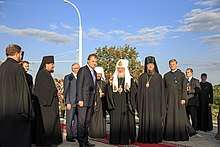
As of 2009 the population of Transnistria comprised about 555,000 people. 90% of the population of Transnistria are citizens of Transnistria.[53] Transnistrians have dual or triple citizenship, including:
- Citizens of Moldova[54] – around 300,000 people (including dual citizens of Moldova and Russia (around 20,000[55]) or of Moldova and the EU states (around 80%) of Romania,[56][57] Bulgaria, or the Czech Republic)
- Citizens of Russia – around 150,000 people (including around 15,000 dual citizens of Belarus, Israel, Turkey); excluding those holding dual citizenship of Russia and of Moldova (around 20,000)
- Citizens of Ukraine – around 100,000 people[58] There are around 20,000–30,000 people with dual citizenship (Moldova and Ukraine, or Russia and Ukraine) or triple citizenship (Moldova, Russia and Ukraine). They are included in the number of Ukrainian citizens.[59]
- Persons without citizenship – around 20,000–30,000 people
There are unsettled border issues between Transnistria and Moldova. Fifteen villages from the eleven communes of Dubăsari District, including Cocieri and Doroțcaia that geographically belong to Transnistria, have been under the control of the central government of Moldova after the involvement of local inhabitants on the side of Moldovan forces during the War of Transnistria. These villages, along with Varnița and Copanca, near Bender and Tiraspol, are claimed by the PMR. One city (Bender) and six villages on the west bank are controlled by the PMR, but are considered by Moldova as a separate municipality (Bender and village of Proteagailovca) or part of the Căușeni District (five villages in three communes).
Tense situations have periodically surfaced due to these territorial disputes, such as in 2005, when Transnistrian forces entered Vasilievca,[60] in 2006 around Varnița, and in 2007 in the Dubăsari-Cocieri area, when a confrontation between Moldovan and Transnistrian forces occurred, however without any casualties.
International relations
Nina Shtanski served as Transnistria's Minister of Foreign Affairs from 2012 to 2015; Vitaly Ignatiev succeeded her as minister.
Government and politics
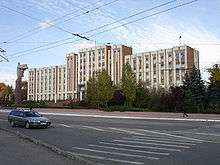
Transnistria is a presidential democracy. The president is directly elected for a maximum of two-consecutive five-year terms. The current President is Vadim Krasnoselsky.
The Supreme Council is a unicameral legislature. It has 43 members who are elected for 5-year terms. Elections take place within a multi-party system.[61] The majority in the Parliament of Transnistria belongs to the Renewal movement that defeated the Republic party affiliated with Igor Smirnov in 2005 and performed even better in the 2010 and 2015 elections. Elections in Transnistria are not recognised by international bodies such as the European Union, as well as numerous individual countries, who called them a source of increased tensions.
There is disagreement over whether elections in Transnistria are free and fair. The political regime has been described as one of "super-presidentialism".[62] During the 2006 presidential election, the registration of opposition candidate Andrey Safonov was delayed until a few days before the vote, so that he had little time to conduct an election campaign.[63][64] Some sources consider election results suspect. In 2001, in one region it was reported that Igor Smirnov collected 103.6% of the votes.[65] The PMR government said "the government of Moldova launched a campaign aimed at convincing international observers not to attend" an election held on 11 December 2005 – but CIS election monitors had ignored that and had declared the ballot democratic.
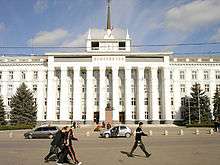
The opposition Narodovlastie party and Power to the People movement were outlawed at the beginning of 2000[66] and eventually dissolved.[67][68]
A list published by the European Union bans travel to the EU for some members of the Transnistrian leadership.[69]
In 2007, the registration of a Social Democratic Party was allowed. This party, led by former separatist leader and member of the PMR government Andrey Safonov, allegedly favours a union with Moldova.
In September 2007, the leader of the Transnistrian Communist Party, Oleg Horjan, was sentenced to a suspended sentence of 1½ years imprisonment for organising unsanctioned actions of protest.[70]
According to the 2006 referendum, carried out by the PMR government, 97.2% of the population voted in favour of "independence from Moldova and free association with Russia."[71] EU and several other countries refused to recognise the referendum results.
Transnistria border customs dispute
On 3 March 2006, Ukraine introduced new customs regulations on its border with Transnistria. Ukraine declared that it would import goods from Transnistria only with documents processed by Moldovan customs offices as part of the implementation of the joint customs protocol agreed between Ukraine and Moldova on 30 December 2005. Transnistria and Russia termed the act an "economic blockade".
The United States, the European Union and OSCE approved the Ukrainian move, while Russia saw it as a means of political pressure. On 4 March, Transnistria responded by blocking the Moldovan and Ukrainian transport at the borders of Transnistria. The Transnistrian block was lifted after two weeks. However, the Moldovan/Ukrainian block remains in place, and holds up progress in status settlement negotiations between the sides.[72] In the months after the regulations, exports from Transnistria declined drastically. Transnistria declared a "humanitarian catastrophe" in the region, while Moldova called the declaration "deliberate misinformation".[73] Cargoes of humanitarian aid were sent from Russia in response.
.jpg)
Russian military presence in Transnistria
The 1992 cease-fire agreement between Moldova and Transnistria established a Russian peace-keeper presence in Transnistria and a 1,200 member Russian military contingent is present in Transnistria. Russian troops stationed in parts of Moldova except Transnistria since the time of the USSR were fully withdrawn to Russia by January 1993.
In April 1995 the former Soviet 14th Guards Army became the Operational Group of Russian Forces, which by the 2010s had shrunk to two battalions and no more than 1,500 troops.
On 21 October 1994, Russia and Moldova signed an agreement that committed Russia to the withdrawal of the troops in three years from the date of entry into force of the agreement;[74] this did not come into effect, however, because the Russian Duma did not ratify it.[16] The Treaty on Conventional Armed Forces in Europe (CFE) included a paragraph about the removal of Russian troops from Moldova's territory and was introduced into the text of the OSCE Summit Declaration of Istanbul (1999) in which Russia had committed itself to pulling out its troops from Transnistria by the end of 2002.[75] However, even after 2002, the Russian parliament did not ratify the Istanbul accords. On 19 July 2004, after it finally passed through parliament President Vladimir Putin signed the Law on the ratification of the CFE Treaty in Europe, which committed Russia to remove the heavy armaments limited by this Treaty.[76] During 2000–2001, although the CFE Treaty was not fully ratified, to comply with it, Moscow withdrew 125 pieces of Treaty Limited Equipment (TLE) and 60 railway wagons containing ammunition from the Transnistrian region of Moldova. In 2002, Russia withdrew three trainloads (118 railway wagons) of military equipment and two (43 wagons) of ammunition from the Transnistrian region of Moldova, and in 2003, 11 rail convoys transporting military equipment and 31 transporting ammunition. According to the OSCE Mission to Moldova, of a total of 42,000 tons of ammunition stored in Transnistria, 1,153 tons (3%) was transported back to Russia in 2001, 2,405 tons (6%) in 2002 and 16,573 tons (39%) in 2003.
Andrei Stratan, the Minister of Foreign Affairs of Moldova, stated in his speech during the 12th OSCE Ministerial Council Meeting in Sofia on 6–7 December 2004 that "The presence of Russian troops on the territory of the Republic of Moldova is against the political will of Moldovan constitutional authorities and defies the unanimously recognized international norms and principles, being qualified by Moldovan authorities as a foreign military occupation illegally deployed on the territory of the state".[77][78] As of 2007 however, Russia insists that it has already fulfilled those obligations. It states the remaining troops are serving as peacekeepers authorised under the 1992 ceasefire, are not in violation of the Istanbul accords and will remain until the conflict is fully resolved.[79] On the other hand, Moldova believes that fewer than 500 soldiers are authorised pursuant to the ceasefire and, in 2015, began to arrest and deport Russian soldiers who are part of the excess forces and attempt to use Moldovan airports.[80]
.jpg)
In a NATO resolution on 18 November 2008, Russia was urged to withdraw its military presence from the "Transdnestrian region of Moldova".[81]
In 2011, US Senator John McCain claimed in a visit to Moldova that Moscow is violating the territorial integrity of Moldova and Georgia and one of the "fundamental norms" of "international behavior".[82] On 21 May 2015, the Ukrainian parliament passed a law terminating five co-operation agreements with Russia. This law effectively terminates the "Agreement on transit of Russian military units temporarily located on the territory of the Republic of Moldova through the territory of Ukraine" dated 4 December 1998.[80][83]
One point of access for Russian soldiers travelling to Transnistria remains Chișinău International Airport and the short overland journey from there to Tiraspol. Over the years, Moldova has largely permitted Russian officers and soldiers to transit the airport on their way to Transnistria, though at some points (for example in 2015) Chișinău has periodically blocked and deported soldiers who were not clearly identified as international peacekeepers or who have failed to give sufficient advance notice. Chișinău would likely only ever agree to the possibility of moving employees, officers, and soldiers of the peacekeeping forces. The passage of soldiers of the 14th Army would be illegal.[84]
On 27 June 2016, a new law entered in force in Transnistria, punishing actions or public statements, including through the usage of mass media, networks of information and telecommunications or the Internet, criticizing the peace-keeping mission of the Russian Army in the Transnistrian Moldovan Republic, or presenting interpretations perceived to be "false" by the Transnistrian government of the Russian Army's peacekeeping mission. The punishment is up to three years of jail for ordinary people or up to seven years of jail if the crime was committed by a person of responsibility or a group of persons by prior agreement.[85]
Military
.jpg)
As of 2007, the armed forces and the paramilitary of Transnistria were composed of around 4,500–7,500 soldiers, divided into four motorised infantry brigades in Tiraspol, Bender, Rîbnița, and Dubăsari.[86] They have 18 tanks, 107 armoured personnel carriers, 73 field guns, 46 anti-aircraft installations, and 173 tank destroyer units. The air force is composed of 9 Mi-8T helicopters, 6 Mi-24 helicopters, 2 Mi-2 helicopters, and several fixed-wing aircraft, including, An-2, An-26 and Yak-18 types.[87] [88]
Demographics
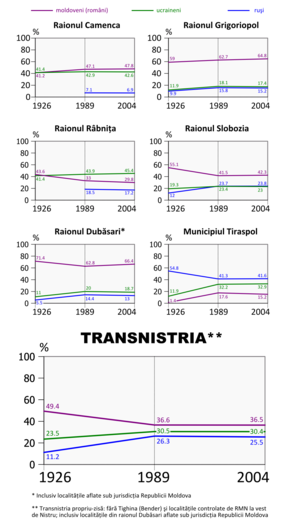
2015 Census
In October 2015, Transnistrian authorities organised a separate census from the 2014 Moldovan Census.[89] According to the 2015 Census, the population of the region was 475,665, a 14.3% decrease from the figure recorded at the 2004 census. The urbanization rate was 69.9%.[6][90]
The largest ethnic groups in 2015 were 161,300 Russians (34%), 156,600 Moldovans (33%), and 126,700 Ukrainians (26.7%). Bulgarians comprised 13,300 (2.8%), Gagauz 5,700 (1.2%) and Belarusians 2,800 (0.6%). Germans accounted for 1,400 or 0.3% and Poles for 1,000 or 0.2%. Others accounted for 5,700 people or 1.2%.[91]
2004 Census
In 2004, Transnistrian authorities organised a separate census from the 2004 Moldovan Census.[92] As per 2004 census, in the areas controlled by the PMR government, there were 555,347 people, including 177,785 Moldovans (32.10%) 168,678 Russians (30.35%) 160,069 Ukrainians (28.81%) 13,858 Bulgarians (2.50%) 4,096 Gagauzians (0.74%), 1,791 Poles (0.32%), 1,259 Jews (0.23%), 507 Roma (0.09%) and 27,454 others (4.94%).[93]
Of these, 439,243 lived in Transnistria itself, and 116,104 lived in localities controlled by the PMR government, but formally belonging to other districts of Moldova: the city of Bender (Tighina), the communes of Proteagailovca, Gîsca, Chițcani, Cremenciug, and the village of Roghi of commune Molovata Nouă.
Moldovans were the largest ethnic group, representing an overall majority in the two districts in the central Transnistria (Dubăsari District, 50.15%, and Grigoriopol District, 64.83%) a 47.82% relative majority in the northern Camenca District, and a 41.52% relative majority in the southern (Slobozia District). In Rîbnița District they were a 29.90% minority, and in the city of Tiraspol, they constituted a 15.24% minority of the population.
As per last census, Russians were the second largest ethnic group, representing a 41.64% relative majority in the city of Tiraspol, a 24.07% minority in Slobozia, a 19.03% minority in Dubăsari, a 17.22% minority in Râbnița, a 15.28% minority in Grigoriopol, and a 6.89% minority in Camenca.
Ukrainians were the third largest ethnic group, representing a 45.41% relative majority in the northern Rîbnița District, a 42.55% minority in Camenca, a 32.97% minority in Tiraspol, a 28.29% minority in Dubăsari, a 23.42% minority in Slobozia, and a 17.36% minority in Grigoriopol. A substantial number of Poles clustered in northern Transnistria were Ukrainianized during Soviet rule.
Bulgarians were the fourth largest ethnic group in Transnistria, albeit much less numerous than the three larger ethnicities. Most Bulgarians in Transnistria are Bessarabian Bulgarians, descendants of expatriates who settled in Bessarabia in the 18th–19th century. The major centre of Bulgarians in Transnistria is the large village of Parcani (situated between the cities of Tiraspol and Bender), which had an absolute Bulgarian majority and a total population of around 10,000.
In Bender (Tighina) and the other non-Transnistria localities under PMR control, ethnic Russians represented a 43.43% relative majority, followed by Moldovans at 26.15%, Ukrainians at 17.08%, Bulgarians at 2.89%, Gagauzians at 1.03%, Jews at 0.34%, Poles at 0.17%, Roma at 0.13%, and others at 7.78%.
1989 Census
At the census of 1989, the population was 679,000 (including all the localities in the security zone, even those under Moldovan control). The ethnic composition of the region has been unstable in recent history, with the most notable change being the decreasing share of Moldovan and Jewish population segments and increase of the Russian. For example, the percentage of Russians grew from 13.7% in 1926 to 25.5% in 1989 and further to 30.4% in 2004, while the Moldovan population decreased from 44.1% in 1926 to 39.9% in 1989 and 31.9% in 2004. Only the proportion of Ukrainians remained reasonably stable – 27.2% in 1926, 28.3% in 1989 and 28.8 in 2004.
Religion
PMR official statistics show that 91% of the Transnistrian population adhere to Eastern Orthodox Christianity, with 4% adhering to Roman Catholicism.[95] Roman Catholics are mainly located in Northern Transnistria, where a notable Polish minority is living.[96]
Transnistria's government has supported the restoration and construction of new Orthodox churches. It affirms that the republic has freedom of religion and states that 114 religious beliefs and congregations are officially registered. However, as recently as 2005, registration hurdles were met with by some religious groups, notably the Jehovah's Witnesses.[97] In 2007, the US-based Christian Broadcasting Network denounced the persecution of Protestants in Transnistria.[98]
Economy
Transnistria has a mixed economy. Following a large scale privatisation process in the late 90s,[99] most of the companies in Transnistria are now privately owned. The economy is based on a mix of heavy industry (steel production), electricity production, and manufacturing (textile production), which together account for about 80% of the total industrial output.[100]
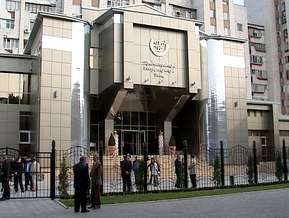
Transnistria has its own central bank, the Transnistrian Republican Bank, which issues its national currency, the Transnistrian ruble. It is convertible at a freely floating exchange rate but only in Transnistria.
Transnistria's economy is frequently described as dependent on contraband[101] and gunrunning,[102][103][104] with some labelling it a mafia state.[105] These allegations are denied by the Transnistrian government, and sometimes downplayed by the officials of Russia and Ukraine.[106]
Economic history
After World War II, Transnistria was heavily industrialised, to the point that, in 1990, it was responsible for 40% of Moldova's GDP and 90% of its electricity,[107] although it accounted for only 17% of Moldova's population. After the collapse of the Soviet Union, Transnistria wanted to return to a "Brezhnev-style planned economy".[108] However, several years later, it decided to head toward a market economy.
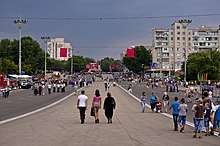
Macroeconomics
According to the government of Transnistria, the 2007 GDP was 6789 mln Transnistrian roubles (appx US$799 million) and the GDP per capita was about US$1,500. The GDP increased by 11.1% and inflation rate was 19.3% with the GDP per capita now being $2,140, higher than Moldova's GDP per capita that is $2,040.[109] Transnistria's government budget for 2007 was US$246 million, with an estimated deficit of about US$100 million[110] that the government planned to cover with income from privatisations.[111] Budget for 2008 is US$331 million, with an estimated deficit of about US$80 million.[112]
In 2004, Transnistria had debts of US$1.2 billion (two-thirds are with Russia) that was per capita about six times higher than in Moldova (without Transnistria).[113] In March 2007 the debt to Gazprom for the acquisition of natural gas increased to US$1.3 billion. On 22 March 2007 Gazprom sold Transnistria's gas debt to the Russian businessman Alisher Usmanov, who controls Moldova Steel Works, the largest enterprise in Transnistria. Transnistria's president Igor Smirnov has announced that Transnistria will not pay its gas debt because "Transnistria has no legal debt to Gazprom".[114][115] In November 2007, the total debt of Transnistria's public sector was up to US$1.64 billion.[112]
According to a 2007 interview with Yevgeny Shevchuk, the then-speaker of the Transnistrian Supreme Council, Transnistria is in a difficult economic situation. Despite a 30% tax increase in 2007, the pension fund is still lacking money and emergency measures must be taken.[116] However, Shevchuk mentioned that the situation is not hopeless and it cannot be considered a crisis, as a crisis means three-month delays in payment of pensions and salaries.[117]
External trade
In 2006, the Transnistrian Republican Bank reported exports of US$422.0 million and imports of US$738.4 million. Compared to a year prior, export decreased 27.2% and import decreased 13.7%. The trade deficit reached US$316.3 million.[118] Over 50% of the export went to the CIS, mainly to Russia, but also to Belarus, Ukraine, and Moldova (which Transnistrian authorities consider foreign).[99][100] Main non-CIS markets for the Transnistrian goods were Italy, Egypt, Greece, Romania, and Germany.[99] The CIS accounted for over 60% of the imports, while the share of the EU was about 23%. The main imports were non-precious metals, food products, and electricity.
After Moldova signed the Association Agreement with the EU in 2014, Transnistria—being de jure part of Moldova—enjoyed the tariff-free exports to the EU. As a result, in 2015, 27% of Transnistria's US$189 million exports went to the EU, while exports to Russia went down to 7.7%. This shift towards the EU market continued to grow in 2016.[119]
Economic sectors
The leading industry is steel, due to the Moldova Steel Works (part of the Russian Metalloinvest holding) in Rîbnița, which accounts for about 60% of the budget revenue of Transnistria.[71] The largest company in the textile industry is Tirotex, which claims to be the second largest textile company in Europe.[120] The energy sector is dominated by Russian companies. The largest power company Moldavskaya GRES (Kuchurgan power station) is in Dnestrovsc and owned by Inter RAO UES,[121] and the gas transmission and distribution company Tiraspoltransgas is probably controlled by Gazprom, although Gazprom has not confirmed the ownership officially. The banking sector of Transnistria consists of 8 commercial banks, including Gazprombank. The oldest alcohol producer KVINT, located in Tiraspol, produces and exports brandy, wines and vodka.
Human rights
The human rights record of Transnistria has been criticised by several governments and international organisations. The 2007 Freedom in the World report, published by the U.S.-based Freedom House, described Transnistria as a "non-free" territory, having an equally bad situation in both political rights and civil liberties.[122]
According to the US Department of State report referring to the year 2006:[123]
The right of citizens to change their government was restricted.... Authorities reportedly continued to use torture and arbitrary arrest and detention.... In Transnistria authorities limited freedom of speech and of the press....Authorities usually did not permit free assembly.... In the separatist region of Transnistria the authorities continued to deny registration and harassed a number of minority religious groups.... The separatist region remained a significant source and transit area for trafficking in persons.... Homosexuality was illegal, and gays and lesbians were subject to governmental and societal discrimination.
Media
There is a regular mix of modern news media in Transnistria with a number of television stations, newspapers, and radio stations.
According to the Organization for Security and Co-operation in Europe (OSCE) the media climate in Transnistria is restrictive and the authorities continue a long-standing campaign to silence independent opposition voices and groups.[124]
According to a US Department of State report for 2006, "Both of the region's major newspapers were controlled by the authorities. There was one independent weekly newspaper in Bender and another in the northern city of Rîbnița.... Separatist authorities harassed independent newspapers for critical reporting of the Transnistrian regime.... Most television and radio stations and print publication were controlled by Transnistrian authorities, which largely dictated their editorial policies and finance operations. Some broadcast networks, such as the TSV television station and the INTER-FM radio station, were owned by Transnistria's largest monopoly, Sheriff, which also holds a majority in the region's legislature.... In July 2005 the Transnistrian Supreme Council amended the election code to prohibit media controlled by the Transnistrian authorities from publishing results of polls and forecasts related to elections."[125]
Moldovan schools
Public education in the Romanian language (officially called Moldovan language in Transnistria) is done using the Soviet-originated Moldovan Cyrillic alphabet. The usage of the Latin script was restricted to only six schools. Four of these schools were forcibly closed by the authorities, who claimed this was due to the refusal of the schools to apply for official accreditation.[126] These schools were later registered as private schools and reopened. This process may have been accelerated by pressure from the European Union.[127]
The OSCE mission to Moldova has urged local authorities in the Transnistrian city of Rîbnița to return a confiscated building to the Moldovan Latin script school in the city. The unfinished building was nearing completion in 2004, when Transnistria took control of it during that year's school crisis.[128]
In November 2005 Ion Iovcev, the principal of a Romanian-language school in Transnistria and active advocate for human rights as well as a critic of the Transnistrian leadership, received threatening calls that he attributed to his criticism of the separatist regime.[125]
Arms control and disarmament
Following the collapse of the former Soviet Union, the Russian 14th Army left 40,000 tonnes of weaponry and ammunition in Transnistria. In later years there were concerns that the Transnistrian authorities would try to sell these stocks internationally, and intense pressure was applied to have these removed by Russia.
In 2000 and 2001, Russia withdrew by rail 141 self-propelled artillery pieces and other armoured vehicles and destroyed locally, 108 T-64 tanks and 139 other pieces of military equipment limited by the Treaty on Conventional Armed Forces in Europe (CFE). During 2002 and 2003 Russian military officials destroyed a further 51 armoured vehicles, all of which were types not limited by the CFE Treaty. The OSCE also observed and verified the withdrawal of 48 trains with military equipment and ammunition in 2003. However, no further withdrawal activities have taken place since March 2004 and a further 20,000 tons of ammunition, as well as some remaining military equipment, are still to be removed.
In the autumn of 2006, the Transnistrian leadership agreed to let an OSCE inspectorate examine the munitions and further access was agreed moving forward.
Recent weapons inspections were permitted by Transnistria and conducted by the OSCE. The onus of responsibility rests on Russia to remove the rest of the supplies.
Transnistrian authorities declared that they are not involved in the manufacture or export of weapons. OSCE and European Union officials stated in 2005 that there is no evidence that Transnistria "has ever trafficked arms or nuclear material" and much of the alarm is due to the Moldovan government's attempts to pressure Transnistria.[129]
In 2007, foreign experts working on behalf of the United Nations said that the historically low levels of transparency and continued denial of full investigations to international monitors have reinforced negative perceptions of the Transnistrian government, although recent co-operation by Transnistrian authorities may have reflected a shift in the attitude of Transnistria.[130] Their report stated that the evidence for the illicit production and trafficking of weapons into and from Transnistria, has in the past been exaggerated, although the trafficking of light weapons is likely to have occurred before 2001 (the last year when export data showed US$900,000 worth of 'weapons, munitions, their parts and accessories' exported from Transnistria). The report also states that the same holds true for the production of such weapons, which is likely to have been carried out in the 1990s, primarily to equip Transnistrian forces.
The OSCE mission spokesman Claus Neukirch spoke about this situation: "There is often talk about sale of armaments from Transnistria, but there is no convincing evidence."[131]
In 2010, Viktor Kryzhanovskyi, Ukraine's special envoy on Transnistria, stated that there was no ongoing arms or drug trafficking through the Transnistrian section of the Ukrainian-Moldovan border at the time.[132]
See also
Notes
- See more in names section.
References
- "Конституция Приднестровской Молдавской Республики". Официальный сайт Президента ПМР.
- "On the situation of Russian schools in Moldova". OSCE. 14 July 2011.
- "Law of the Moldavian Soviet Socialist Republic on the Functioning of Languages on the Territory of the Moldavian SSR". U.S. English Foundation Research. 2016. Archived from the original on 21 September 2016.
- "Russian language in Moldova could lose their status (Русский язык в Молдове может потерять свой статус)". KORRESPONDENT. 6 April 2013.
- The Supreme Soviet changed the official name of the republic from Pridnestrovian Moldavian Soviet Socialist Republic to Pridnestrovian Moldavian Republic on 5 November 1991. See: "Postanovlenie verkhovnogo soveta Pridnestrovskoi Moldavskoi Respubliki ob izmenenii nazvaniia respubliki," Dnestrovskaia pravda, 6 November 1991, 1.
- Populația Transnistriei a scăzut cu 14,3 la sută Archived 3 August 2017 at the Wayback Machine
- https://web.archive.org/web/20130616004647/http://www.vspmr.org/Upload/File/doklad2007.rar Supreme Council (Transnistria)
- About Abkhazia – Abkhazia.info Archived 21 July 2011 at the Wayback Machine. English translation: Google translator. Link was not available/working 21 December 2014.
- Law No. 173 from 22 July 2005 "About main notes about special legal status of settlements of left bank of Dnestr (Transnistria)": Moldovan, Russian
- "Moldova. territorial unit: Stinga Nistrului (Transnistria)". CIA World Factbook. CIA. Retrieved 30 June 2012.
- Herd, Graeme P.; Moroney, Jennifer D. P. (2003). Security Dynamics in the Former Soviet Bloc. Routledge. ISBN 0-415-29732-X.
- Zielonka, Jan (2001). Democratic Consolidation in Eastern Europe. Oxford University Press. ISBN 0-19-924409-X.
- Jos Boonstra, Senior Researcher, Democratisation Programme, FRIDE. Moldova, Transnistria and European Democracy Policies Archived 8 August 2018 at the Wayback Machine, 2007
- Hinteregger, Gerald; Heinrich, Hans-Georg (2004). Russia – Continuity and Change. Springer. p. 174. ISBN 3-211-22391-6.
- Rosenstiel, Francis; Lejard, Edith; Boutsavath, Jean; Martz, Jacques (2002). Annuaire Europeen 2000/European Yearbook 2000. Martinus Nijhoff Publishers. ISBN 90-411-1844-6.
- Bartmann, Barry; Tozun, Bahcheli (2004). De Facto States: The Quest for Sovereignty. Routledge. ISBN 0-7146-5476-0.
- European Union Border Assistance Mission to Moldova and Ukraine (EUBAM), November 2007
- "Background – EU Border Assistance Mission to Moldova and Ukraine". Eubam.org. Archived from the original on 11 May 2013. Retrieved 30 May 2013.
- Der n-tv Atlas. Die Welt hinter den Nachrichten. Bertelsmann Lexikon Institut. 2008. page 31
- OSCE: De Gucht Discusses Montenegro Referendum, Frozen Conflicts, GlobalSecurity.org, Radio Free Europe/Radio Liberty, May 2006
- Vladimir Socor,"Frozen Conflicts in the Black Sea-South Caucasus Region". Archived from the original on 5 June 2013. Retrieved 26 March 2014., IASPS Policy Briefings, 1 March 2004
- Абхазия, Южная Осетия и Приднестровье признали независимость друг друга и призвали всех к этому же (in Russian). Newsru. 17 November 2006. Retrieved 26 March 2014.
- "Head of Foreign Ministry of the Republic of South Ossetia congratulated Minister of Foreign Affairs of the PMR with Sixth Anniversary of Creation of Community for Democracy and Rights of Nations". The Ministry of Foreign Affairs of the PMR. 15 June 2012. Retrieved 26 March 2014.
- Vichos, Ioannis F. "Moldova's Energy Strategy and the 'Frozen Conflict' of Transnistria". Ekemeuroenergy.org. Archived from the original on 15 June 2013.
- Regions and territories: Trans-Dniester, BBC News, 7 March 2007
- The black hole that ate Moldova: A glimpse inside Transdniestria, Economist, 3 May 2007
- "Union of Moldavians in Transnistria: We have no grounds to distrust Smirnov". Strategiya-pmr.ru. 7 December 2011. Archived from the original on 16 June 2013. Retrieved 30 May 2013.
- "Map of Romania in 1941–1944". Retrieved 30 June 2012.
- Dallin, Alexander (1957). "Romanization". Odessa, 1941–1944: A Case Study of Soviet Territory Under Foreign Rule. Center for Romanian Studies. pp. 87–90. ISBN 9789739839112. Retrieved 18 March 2014.
- "Romania and The Nazi-Soviet war, 1941–1944". United States Holocaust Memorial Museum. Retrieved 18 March 2014.
- Casu, Igor. "Stalinist terror in Soviet Moldavia, by Igor Casu". Usm-md.academia.edu. Retrieved 30 May 2013.
- Timeline: Moldova BBC Country Profile: Moldova
- Chechnya: Tombstone of Russian Power, Anatol Lieven, Yale University Press, 1999, ISBN 0-300-07881-1, pp 246
- Can Liberal Pluralism Be Exported?, Will Kymlicka, Magdalena Opalski, Oxford University Press, 2001, ISBN 0-19-924063-9, pp 208
- The painful past retold Social memory in Azerbaijan and Gagauzia, Hülya Demirdirek, Postkommunismens Antropologi, University of Copenhagen, 12–14 April 1996.
- Andrei Panici. Romanian Nationalism in the Republic of Moldova, Global Review of Ethnopolitics, vol. 2 no. 2 (January 2003), p.37–51.
- "Could Transnistria be the next Crimea?". Channel 4 News.
- Hare, Paul (1999). "Who are the Moldovans?". In Paul Hare; Mohammed Ishaq; Judy Batt (eds.). Reconstituting the market: the political economy of microeconomic transformation. Taylor & Francis. p. 363 & p. 402. ISBN 90-5702-328-8. Retrieved 30 October 2009.
- Modern Hatreds: The Symbolic Politics of Ethnic War, Stuart J. Kaufman, Cornell University Press, 2001, ISBN 0-8014-8736-6, pp. 143
-
- Kolsto, et al. "The Dniester Conflict
- Between Irredentism and Separatism," Europe-Asia Studies, Vol. 45, No. 6 (1993): 108.
- "Ukaz Prezidenta Soiuza Sovetskikh Sotsialisticheskikh Respublik O Merakh po Normalizatsii Obstanovki v SSR Moldova," Sovetskaia Moldova, no. 295 (17249), 1990-12-23, 1.
- (in Russian) Несколько хронологических данных о начале и эволюции войны Archived 13 March 2013 at the Wayback Machine
- (in Russian) Mikhail Bergman, Вождь в чужой шкуре. (in Russian)
- Moldova Matters: Why Progress is Still Possible on Ukraine's Southwestern Flank, Pamela Hyde Smith, The Atlantic Council of the United States, March 2005
- Netherlands Institute of International Relations – The OSCE Moldova and Russian diplomacy 2003 Archived 11 October 2006 at the Wayback Machine page 109
- "Talk conditions of Transnistria on March 2011". Osw.waw.pl. 2 March 2011. Archived from the original on 24 June 2012. Retrieved 30 June 2012.
- "Transnistria wants to merge with Russia". Vestnik Kavkaza. Retrieved 18 March 2014.
- "Moldova's Trans-Dniester region pleads to join Russia". Bbc.com. 1 January 1970. Retrieved 18 March 2014.
- <%= item.timeFlag %>. "Dniester public organizations ask Russia to consider possibility of Transnistria accession". En.itar-tass.com. Retrieved 18 March 2014.
- Trygve Kalland and Claus Neukirch, Moldovan Mission seeks solution to Dorotcaia's bitter harvest, Organization for Security and Co-operation in Europe, 10 August 2005
- New checkpoint to appear in Moldova conflict zone after clash, RIA Novosti, 13 January 2007
- (in Romanian) Locuitorii satului Vasilievca de pe malul stâng al Nistrului trăiesc clipe de coșmar, Deutsche Welle, 17 March 2005.
- Republica Pridnestrovie
- CHISINAU overstates the number of Moldovan citizens living in Transnistria, MD: Press, 2006, archived from the original on 23 May 2013
- 170,000 with citizenship Russia, Profvesti, 21 April 2013
- Double citizenship Moldova and Romania in 2013, RU: Rosbalt, 2 April 2013
- Romanian passport received 80 percent of Moldovans, MD: NBM
- Double citizenship Moldova and Romania in 2013. Citizenship Russia or Ukraine in PMR, RU: Rosbalt, 2 April 2013
- Transdniestrian Ukrainians will continue to vote in the territory of the Republic of Moldova, RU: NR2, archived from the original on 16 May 2013
- "Transnistrian Militia Withdrew Its Posts from Vasilievca", Azi, MD, retrieved 18 October 2006
- "PMR Supreme Council (Parliament of Transnistria's official website)". Vspmr.org. 17 June 2012. Retrieved 30 June 2012.
- Moldova and the Dniestr Region: Contest Past, Frozen Present, Speculative Futures? Archived 9 June 2008 at the Wayback Machine Herd, Graeme P., Conflict Studies Research Centre, 2005. Accessed 25 May 2007.
- "Tiraspol not willing to register opposition representative in electoral race". Politicom.moldova.org. 21 November 2006. Archived from the original on 12 March 2012. Retrieved 30 June 2012.
- Andrey Safonov will be able to enter the election for the seat of president Archived 27 September 2007 at the Wayback Machine
- "US Department of State, Country Report on Human Rights Practices in Moldova – 2003". State.gov. 25 February 2004. Retrieved 30 June 2012.
- Original Communism, Sorin Ozon, Romanian Center for Investigative Journalism, 13 July 2006.Accessed:31 October 2010. Archived 27 September 2007 at the Wayback Machine
- Țăranu, A; Grecu, M. "The policy of linguistic cleansing in Transnistria". Archived from the original on 29 May 2006. Retrieved 30 March 2017.CS1 maint: BOT: original-url status unknown (link), page 26-27. Retrieved 27 December 2006.
- (in Russian) Министерство юстиции ПМР вынесло предупреждение общественному движению "Власть народу! За социальную справедливость!" и "Партии народовластия" Archived 3 March 2016 at the Wayback Machine (Ministry of Justice of PMR warned Power to the People movement and Narodovlastie party), Ольвия Пресс, 27-02-01.
- Council Decision 2006/96/CFSP of 14 February 2006 implementing Common Position 2004/179/CFSP concerning restrictive measures against the leadership of the Transnistrian region of the Republic of Moldova European Union Law – Official Journal. 2 February 2006. Retrieved 27 December 2006.
- "Transnistrian Communist Party leader released on probation". Transnistria.md. 26 September 2007. Archived from the original on 15 October 2007. Retrieved 30 June 2012.
- Moldova Strategic Conflict Assessment (SCA), Stuart Hensel, Economist Intelligence Unit. Archived 25 October 2007 at the Wayback Machine
- "Olvia Press: "Valeri Litskai: A situation based on pressure and threats cannot be considered favorable for the revival of contacts"". Olvia.idknet.com. Archived from the original on 5 February 2012. Retrieved 30 June 2012.
- "Russia's humanitarian assistance is a planned propagandist action, Chișinău claims". Politicom.moldova.org. 23 March 2006. Archived from the original on 6 October 2011. Retrieved 30 June 2012.
- "Nezavisimaya Moldova", 25 October 1994; Informative Report of FAM of RM, nr.2, October 1994, pp. 5–6
- Mihai Grecu, Anatol Țăranu, Trupele Ruse în Republica Moldova (Culegere de documente și materiale). Chișinău, 2004, p. 600.
- "Interfax", Moscow, in Russian, 0850 gmt, 7 July 2004
- Mihai Gribincea, "Russian troops in Transnistria–a threat to the security of the Republic of Moldova", Institute of Political and Military Studies, Chișinău, Moldova Archived 12 May 2013 at the Wayback Machine Russia continues to 'sustain the Dniestr region as a quasi-independent entity through direct and indirect means'
- MC.DEL/21/04, 6 December 2004
- Interfax. NATO must recognize Russia's compliance with Istanbul accords 14 July 2007. Retrieved 18 November 2007. Archived 4 June 2011 at the Wayback Machine
- Kucera, Joshua (25 May 2015). "Russian Troops In Transnistria Squeezed By Ukraine And Moldova". EurasiaNet.org. Open Society Foundations. Retrieved 31 May 2015.
- iBi Center (18 November 2008). "NATO-resolution. 11. b". Nato-pa.int. Archived from the original on 20 March 2012. Retrieved 30 June 2012.
- "McCain Backs Demand For Russian Troop Withdrawal From Transdniester". Rferl.org. 13 June 2011. Retrieved 30 May 2013.
- "Ukraine blocked Russian contingent to Transnistria (Moldova)". 22 May 2015. Retrieved 31 May 2015.
- "With Russia Boxed In, Frozen Transdniester Conflict Could Heat Up". Radio Free Europe Radio Liberty. 31 May 2015.
- Liubec, Igor (29 June 2016). "La Tiraspol, faci pușcărie, dacă negi "rolul pozitiv" al armatei ruse" [Those who deny the "positive role" of the Russian Army in Tiraspol face prison]. Deschide Știrea (in Romanian). Archived from the original on 2 January 2018. Retrieved 2 January 2017.
- km.ru, Приднестровье показало мускулы Archived 4 August 2012 at Archive.today, 6 September 2007 (in Russian)
- "Приднестровье показало мускулы". km.ru (in Russian). 15 March 2008. Archived from the original on 15 March 2008. Retrieved 7 August 2020.
- "Law enforcement and armed forces of Pridnestrovie". Pridnestrovie.net. 27 September 2007. Archived from the original on 4 November 2009. Retrieved 7 August 2020.
- Краткие предварительные итоги переписи населения Приднестровья 2015 года (in Russian)
- "Transnistria a pierdut "un oraș"". Radio Europa Liberă.
- "Статистический ежегодник 2017 - Министерство экономического развития Приднестровской Молдавской Республики". mer.gospmr.org.
- Trends in Europe and North America (Explanatory Notes), United Nations Economic Commission for Europe (UNECE). Archived 19 March 2011 at the Wayback Machine
- "Official data from 2004 census and comparison with the 1989 census, by Olvia Press". Olvia.idknet.com. Archived from the original on 5 November 2012. Retrieved 30 June 2012.
- "Министерство экономического развития Приднестровской Молдавской Республики".
- "World Directory of Minorities and Indigenous Peoples – Transnistria (unrecognised state): Overview". Refworld. United Nations High Commissioner for Refugees. Archived from the original on 16 October 2012. Retrieved 30 June 2012.
- "Ethnic map of Transnistria", CEU monitor, Google, archived from the original (JPEG) on 26 February 2010
- "Moldova", International Religious Freedom Report, US: Department of State Bureau of Democracy, Human Rights, and Labor, 2005
- Lane, Gary (6 April 2007), "Christians Face Abuse from Corrupt Regime", CBN News, archived from the original on 18 April 2009.
- Moldova: Regional tensions over Transdniestria (PDF), International Crisis Group, 17 June 2004
- Transnistria, Center for Economic Policies of IDIS "Viitorul"
- "An illegal business that's smoking". Business New Europe. 18 April 2012. Archived from the original on 2 January 2014. Retrieved 3 September 2013.
- "Ющенко: Украина недополучает из-за контрабанды из Приднестровья". Korrespondent. 23 March 2006. Retrieved 3 September 2013.
- "Hotbed of weapons deals". The Washington Times. 18 January 2004. Retrieved 3 September 2013.
- СВИРИДЕНКО, АЛЕКСАНДР; НЕПРЯХИНА, НАТАЛИЯ (10 March 2006). "Приднестровье самоизолировалось". Kommersant-Ukraine. Archived from the original on 2 January 2014. Retrieved 3 September 2013.
- Bulavchenko, Aliona (8 February 2002). ДНЕСТРОВСКИЕ ПОРОГИ. Zerkalo Nedeli (in Russian). Retrieved 2 January 2014.
- Queremos zonas de libre comercio tanto al Este como hacia el Oeste El Pais. 4 June 2013.
- Mackinlay, John; Cross, Peter, eds. (2003), Regional Peacekeepers: The Paradox of Russian Peacekeeping, United Nations University Press, p. 135, ISBN 92-808-1079-0
- Dunlop, John B (Autumn 1993), "Will a Large-Scale Migration of Russians to the Russian Republic Take Place over the Current Decade?", International Migration Review, 27 (3): 605–29, PMID 12287571, citing "Russian Radio", Russia and CIS Today, WPS, 21 September 1992, p. 976/16
- Доклад "Социально-экономическое развитие Приднестровской Молдавской Республики" за года (уточнение) [Socio-economical development of the Pridnestrovian Moldovan Republic], Statistical service of the Ministry of Economy of Transnistria, 2007, archived from the original on 16 June 2013
- Transnistrian parliament adopts region's budget for 2007, MD: Conflict, archived from the original on 27 September 2007
- "Privatization will solve the budget problem", PMR News, RU: Tiras, 21 February 2007, archived from the original on 16 October 2007
- "Евгений Шевчук: бюджет Приднестровья–отражение реальной ситуации в экономике". RU: Nr2. Archived from the original on 14 March 2012. Retrieved 30 June 2012.
- Popescu, Nicu (2005–2006), Democracy in Secessionism: Transnistria and Abkhazia's Domestic Policies (PDF), International Policy Fellowship Program
- "Moscow's Hand Tired of Giving", Kommersant, 6 April 2007, archived from the original on 28 May 2007
- ""Газпром" передал Приднестровье Алишеру Усманову", Nezavisimaya Gazeta, RU, 23 March 2007
- "Shevchuk answering a question about 2007 Transnistrian budget". VSPMR. Archived from the original on 7 February 2012. Retrieved 30 June 2012.
- "Shevchuk explaining that the economic situation is not critical". VSPMR. Archived from the original on 7 February 2012. Retrieved 30 June 2012.
- Transnistrian Republican Bank, Tiraspol: CBPMR, 2007.
- "Moldova: Separatist Transnistria Region Reorienting Trade from Russia to EU" EarasiaNet, 4 May 2016
- "Tirotex official website". Tirotex.com. Archived from the original on 5 February 2012. Retrieved 30 June 2012.
- "Annual Report of Inter RAO UES" (PDF). Retrieved 30 June 2012.
- Freedom House, 2007 "Freedom in the World" report Archived 14 February 2007 at the Library of Congress Web Archives
- United States Department of State: Country Reports on Human Rights Practices – 2006
- OSCE – Media in Transdniestria Archived 28 May 2013 at the Wayback Machine
- United States Department of State report for 2006
- Statement by the Ministry of Education, Pridnestrovian Moldavian Republic, on the question of children's educational rights insurance Archived 28 February 2016 at the Wayback Machine, published by Olvia-Press 15 July 2004
- "Several Transnistrian officials were banned from traveling through EU" (PDF). Retrieved 30 May 2013.
- "Russian version". Archived from the original on 15 April 2011.
- Lobjakas, Ahto (11 October 2005). "Western Diplomats Say Reports Of Smuggling From Transdniester Likely Exaggerated". RFE/RL. Retrieved 30 May 2013.
- UNDP: 2006 Small arms and light weapons survey of Moldova Archived 23 May 2013 at the Wayback Machine, SEESAC 1 July 2007, ISBN 86-7728-014-6
- Conflict Studies Research Centre, Moldova & The Dniestr Region: Contested Past, Frozen Present, Speculative Futures? Archived 26 June 2008 at the Wayback Machine, Graeme P. Herd.
- Kravchenko, Vladimir (19 March 2010). Спецпредставитель Украины: Заявления Молдовы о транзите наркотиков и оружия через Приднестровье — безосновательны. Zerkalo Nedeli (in Russian). Retrieved 2 January 2014.
External links

- Profile of Trans-Dniester, BBC News.
- The black hole that ate Moldova, The Economist.
- Transdniester Conflict Was Long In The Making, Radio Free Europe.
- "Moldova, Transnistria, and European Democracy Polices", Jos Boonstra, FRIDE, February 2007.
- Matsuzato, Kimitaka: "Canonization, Obedience, and Defiance: Strategies for Survival of the Orthodox Communities in Transnistria, Abkhazia, and South Ossetia" in the Caucasus Analytical Digest No. 20
- Information on Transnistria/Pridnestrovie in English and Russian
- (in Russian) PMR Presidential website
- (in English and Russian) Website of the Supreme Council (Parliament) of PMR
- (in English and Russian) Website MFA of Pridnestrovie
- (in English and Russian) Pridnestrovian News – Website of the official information agency of Pridnestrovie
- (in English) Transnistria Guide
- (in English, Russian, and Romanian) Transnistria.md News and interviews. Moldova administration
- (in Russian) Radio PMR. Radio-News. Pridnestrovie administration.
- (in Russian) First Pridnestrovian TV Channel – State television of Pridnestrovie
- (in Russian) On-line TV PMR. Video, news and interviews. Pridnestrovie administration
.svg.png)
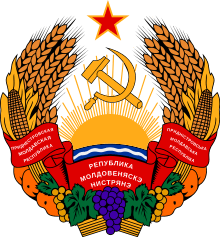
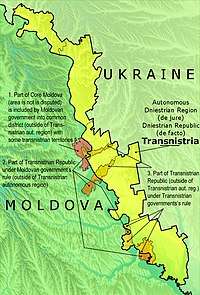
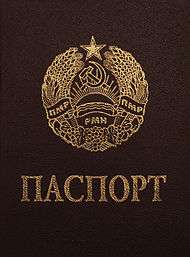
.jpg)
